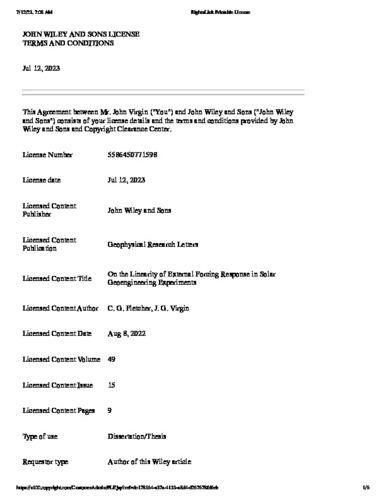| dc.description.abstract | Global, annual mean surface temperature continues to rise in the wake of the Paris Agreement goal of limiting warming to 2.C and pursing efforts to limit warming to less than 1.5 C. Research paradigms have arisen to analyze projections of future warming, as well as understanding the drivers of anthropogenic climate change since the preindustrial era. One
such paradigm is the characterization of anthropogenic emissions of greenhouse gases as an external radiative forcing on the climate system, as well as feedbacks from the climate response to forcing that augment the rate in which the Earth system reestablishes energy balance. As surface temperatures rise, solar geoengineering has been proposed as a means
to deliberately alter Earth’s energy balance and achieve Paris Agreement goals through reducing the amount of incoming shortwave radiation from reaching the surface. Through the lens of the conventional forcing-feedback framework, solar geoengineering is challenging to frame due to the purposeful introduction of an external forcing in order to suppress
surface warming, and therefore feedback. Furthermore, the potential for multiple external forcings via solar geoengineering to produce feedbacks from an energetic perspective, even in the absence of surface warming, is poorly understood. This thesis attempts to adapt the forcing-feedback paradigm to define potential radiative feedbacks on the climate system as
a result of solar geoengineering through three studies.
First, we perform an analyses of radiative forcing and feedback between two versions of the Canadian Earth System Model (CanESM) to understand what is physically driving differences in surface warming. We find little difference in radiative forcing from increased CO2 between the two model versions. More positive radiative feedbacks produce a larger amount of warming in CanESM5, primarily from a reduction boundary layer clouds across the equatorial Pacific that reduced the Earth’s albedo to a greater extent. This analysis was essential to understand how radiative feedbacks, specifically from clouds, can impact the rate surface warming.
Next, we analyzed radiative forcing from both increased CO2 and a reduced solar constant using the Community Earth System Model (CESM). We find that the magnitude of solar forcing required to offset the positive radiative forcing from quadrupling CO2 is sensitive to radiative adjustments from both forcings. Radiative adjustments, which are climate responses from an external forcing in the absence of surface warming that impact Earth’s energy balance, as a result of reductions in cloud fraction had a dampening effect on the reduction of the solar constant. This work informed how solar constant tuning, which we used as a proxy for more realistic representations of solar geoengineering, can produce changes in cloud fraction that impact planetary albedo and therefore the amount solar forcing required to achieve energy balance.
Finally, we extend the work of the first two studies by defining and investigating potential geoengineering radiative feedbacks in a transient solar geoengineering experiment using CESM. We reduce the solar constant over time in an idealized geoengineering experiment that maintains near-zero global mean surface warming in the wake of increasing CO2 and find a decreasing trend in optically thick tropical clouds. Reductions in cloud fraction reduced planetary albedo, which further decreased the amount of solar forcing needed to achieve the same net energy reduction at the surface, thus producing a positive radiative feedback loop in absence of global mean surface warming. This work highlights the need to understand potential feedbacks from realizable methods of solar geoengineering such as stratosphere aerosol injections. | en |


